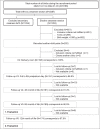The effect of early skin-to-skin contact after cesarean section on breastfeeding duration and development of atopic-allergic diseases
- PMID: 38269325
- PMCID: PMC10807137
- DOI: 10.18332/ejm/176213
The effect of early skin-to-skin contact after cesarean section on breastfeeding duration and development of atopic-allergic diseases
Abstract
Introduction: Breastfeeding to strengthen the immune system suggests allergy prevention as a possible option. The connection between breastfeeding and the development of atopic-allergic diseases is being discussed. The primary aim of this work was to investigate an association of the first early skin-to-skin contact following cesarean section with the development of atopic diseases within the 1st year of life.
Methods: The present study was conducted as a bicentric prospective cohort study in central Germany with a 15-month recruitment period. Data collection was by telephone interviews with a follow-up of 12 months. The statistical evaluation procedure was based on a hierarchical test of the association of early skin-to-skin contact between mother and child with the two main outcome measures. The primary outcome is the duration of breastfeeding. The second outcome is the onset of atopic-allergic disease within the 1st year of life.
Results: Mothers breastfed longer if they had skin-to-skin contact within the first 30 minutes postpartum [χ²(df=5) = 19.020, p=0.002], if they breastfed their newborns early immediately after birth (p<0.001), and if the first skin-to-skin contact lasted more than one hour [χ²(df=4) = 19.617, p<0.001]. Regarding atopic-allergic diseases, no significant effects of skin-to-skin contact were found in relation to disease development. Regarding breastfeeding, no significant effects of atopic-allergic diseases could be detected either.
Conclusions: The results of this study reflect the benefits of skin-to-skin contact in the context of breastfeeding and atopic disease. The current scientific knowledge regarding skin contact and the development of atopic-allergic diseases should be extended and deepened.
Keywords: atopic dermatitis; atopic-allergic diseases; breastfeeding; cesarean section; skin contact; skin-to-skin contact.
© 2024 Stephan Y. et al.
Conflict of interest statement
The authors have completed and submitted the ICMJE Form for Disclosure of Potential Conflicts of Interest and none was reported.
Figures




Similar articles
-
Prevention of allergic disease in childhood: clinical and epidemiological aspects of primary and secondary allergy prevention.Pediatr Allergy Immunol. 2004 Jun;15 Suppl 16:4-5, 9-32. doi: 10.1111/j.1399-3038.2004.0148b.x. Pediatr Allergy Immunol. 2004. PMID: 15125698 Review.
-
Effects of a dietary and environmental prevention programme on the incidence of allergic symptoms in high atopic risk infants: three years' follow-up.Acta Paediatr Suppl. 1996 May;414:1-21. doi: 10.1111/j.1651-2227.1996.tb14267.x. Acta Paediatr Suppl. 1996. PMID: 8831855 Clinical Trial.
-
Nutrition, growth, and allergic diseases among very preterm infants after hospital discharge.Dan Med J. 2013 Feb;60(2):B4588. Dan Med J. 2013. PMID: 23461996 Review.
-
Implementation of early essential neonatal care for newborns delivered by cesarean section in Jiaxing: a single-center prospective randomized controlled trial.Int Breastfeed J. 2024 May 3;19(1):31. doi: 10.1186/s13006-024-00635-y. Int Breastfeed J. 2024. PMID: 38702713 Free PMC article. Clinical Trial.
-
Duration and exclusiveness of breastfeeding and risk of childhood atopic diseases.Allergy. 2017 Dec;72(12):1936-1943. doi: 10.1111/all.13195. Epub 2017 Jun 2. Allergy. 2017. PMID: 28449362
References
-
- Biedermann T, Heppt W, Renz H, Röcken M, eds. Allergologie. 2. Auflage. Springer Berlin Heidelberg; 2016.
LinkOut - more resources
Full Text Sources
Miscellaneous
